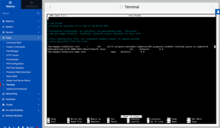This article has multiple issues. Please help improve it or discuss these issues on the talk page. (Learn how and when to remove these messages)
|
Webmin is a web-based server management control panel for Unix-like systems. Webmin allows the user to configure operating system internals, such as users, disk quotas, services and configuration files, as well as modify and control open-source apps, such as BIND, Apache HTTP Server, PHP, and MySQL.[6][7]
 | |
| Developer(s) | Jamie Cameron Ilia Rostovtsev and the Webmin community[1] |
|---|---|
| Initial release | October 5, 1997 (version 0.1) |
| Stable release | 2.202[2] |
| Repository | |
| Written in | Perl |
| Operating system | Linux (RHEL, Fedora, CentOS, AlmaLinux, Rocky Linux, Oracle Linux, Debian, Ubuntu), FreeBSD, OpenSUSE and other Unix-like operating systems[3][4] |
| Available in | English, and other 41 languages[5] |
| Type | Control panel |
| License | BSD 3-clause "New" or "Revised" License |
| Website | www |




History
editWebmin, written by Jamie Cameron, was first released as version 0.1 in October 1997. It was originally written during the time that Cameron administered a DNS server and needed an easy-to-use interface to allow users to make changes to the DNS records without giving them root access to the server.[8] Over time, various themes, a dashboard that displays CPU, RAM, and disk space usage with visual gauges, and a sidebar with a search function were also added.[9]
Financial support for the Webmin project came from the Linux distribution companies Caldera and MSC Linux, as well as many user contributions of code patches, hundreds of modules, language translations, and user suggestions.[8]
In 2019, a backdoor was discovered which would allow a remote attacker to execute malicious commands with root privileges on the machine running Webmin. This backdoor exploit was present on versions 1.882-1.921, when a network admin would enable the password expiration policy. Developers of Webmin believed that the backdoor being introduced was the result of a malicious injection to the code via the online source code repository SourceForge.[10]
Since its release, the Webmin user interface, its appearance, and its many features have changed dramatically using code that has been completely rewritten over the subsequent versions.This includes the overhaul brought by Webmin 2.0, which enforced strict HTTP Strict Transport Security policy for SSL, and gave options to users upgrading from older versions.[11][12]
General description
editWebmin is largely based on Perl, running as its own process and web server. It defaults to TCP port 10000 for communicating, and can be configured to use SSL if OpenSSL is installed with additional required Perl modules. Webmin is built around over 110 standard modules, which have an interface to the configuration files and the Webmin server, which makes it simple to add new functionality. Due to Webmin's modular design, it is possible for anyone who is interested to write plugins for desktop configuration. Webmin allows for controlling many machines through a single interface, or seamless login on other Webmin hosts on the same subnet or LAN.
Webmin is released under the BSD license.
If a plugin for certain tasks is not available, it is possible to open a terminal and perform various task through a command line interface (CLI). This is especially useful if using SSH (or similar) is not an option.
Inclusion in distributions
editWhile Webmin was included in the official repositories of some Linux distributions (Debian and Ubuntu), it was removed from those because Webmin was not compatible with the way that the distributions' packages handled configuration files and caused unexpected issues with systems.[13]
Related software
editWebmin can be expanded by installing modules,[7] which can be custom made. Aside from this, there are two other major projects that extend the functionality of Webmin:
- Usermin presents and controls a subset of the features available in Webmin, such as webmail and other user-level tasks, rather than administrator-level tasks.
- Virtualmin, which is a web hosting control panel. Virtualmin enables users to host websites under domains, and gives the server admin and the end user a simple interface for managing their websites.
Webmin released Minecraft Server Module 1.0 in January 2013, and version 1.1 in March 2013. The module presents a very basic GUI for server administration. The Webmin Minecraft server is free and open source with no limitations on simultaneous players.
See also
editReferences
edit- ^ "Introduction to Webmin". Webmin. Retrieved 11 February 2007.
- ^ "2.202". 12 August 2024. Retrieved 12 August 2024.
- ^ "Webmin Installation". Webmin. 2 October 2017. Retrieved 7 October 2018.
- ^ "Installation - Webmin Documenation". webmin.
- ^ "Supported Languages". Webmin. 2 October 2017.
- ^ Federico Kereki (2008-04-01). "Graphic Administration with Webmin". Linux Journal. Retrieved 2014-04-08.
- ^ a b Shawn Powers (July 2012). "Webmin—the Sysadmin Gateway Drug". The Open-Source Classroom. Porky.linuxjournal.com. Archived from the original on 2014-04-08. Retrieved 2014-04-08.
- ^ a b "Introduction - Webmin Documentation". doxfer.webmin.com. Retrieved 2023-05-01.
- ^ Contributor, Inmotion Hosting (2021-12-02). "What is Webmin and Why Use it?". InMotion Hosting Blog. Retrieved 2023-05-01.
{{cite news}}:|last1=has generic name (help) - ^ "Backdoor found in Webmin, a popular web-based utility for managing Unix servers". ZDNET. Retrieved 2023-05-19.
- ^ "Webmin 2.0 Released For Open-Source Web-Based Server Management/Administration". www.phoronix.com. Retrieved 2023-05-19.
- ^ Kocher, Laveesh (2022-08-24). "Webmin 2.0 Is Now Available For Open Source Web-Based Server". Open Source For You. Retrieved 2023-05-19.
- ^ Ubuntu documentation Webmin